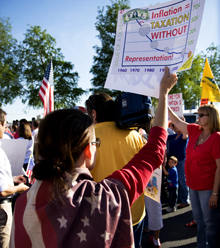Tea Party Changes Landscape for Midterm Elections
The conservative Tea Party movement demonstrated that it is a legitimate political force with wins over mainstream Republicans in midterm primary elections earlier this month. These upset victories sent GOP strategists scrambling and will likely set the tone for intraparty dialogue among Republicans.

A Tea Party gathering in Metairie, La., brings out signs and supporters. The conservative movement chalked up big wins in recent primary elections. (Photo by Ryan Rivet)
“Right now the Republican establishment has very clearly picked up that [the Tea Party] is going to be a major component of its support base,” says Brian Brox, Tulane assistant professor of political science. “They need to find a way to reconcile it and merge it and help this group play well with more traditional factions within the party.”
Brox says Tea Party candidates on the ballot force the GOP to vigorously contest races they would normally chalk up in the win column, which could pave the way for Democrats to preserve their majority in the Senate.
“When the Tea Party candidate becomes the Republican nominee, they pull the party's position to the right,” Brox says. “That makes it harder to appeal to independents and conservative Democrats, which forces the national party to devote more resources to that race, instead of using their funds in other toss-up races.”
While the Republican Party will publicly present a united front, Brox says the success of the populist Tea Party candidates has drawn a line in the conservative sand.
“This will really be a fight within the Republican Party about ideological purity versus practical politics,” Brox says. “The discussion on the right side of the aisle will be about what it means to be a Republican or a conservative, and if they win in November, what it means to be a governing conservative.”
The Tea Party's primary success notwithstanding, Brox says that historical trends do not bode well for the movement's ability to make an impact in the long term.
“Third-party movements in America come most frequently when there are periods of crisis. When peace and prosperity come back, people become less motivated, less angry and stop searching for these kind of alternatives.”
